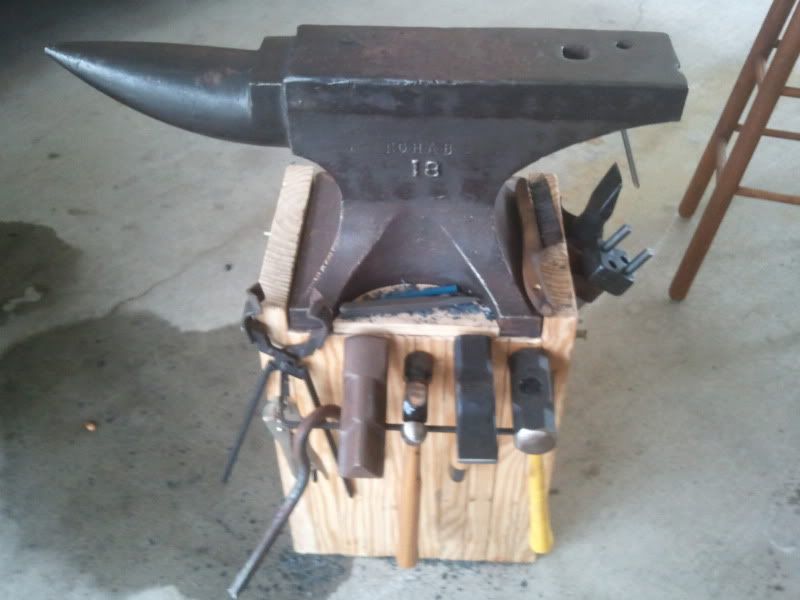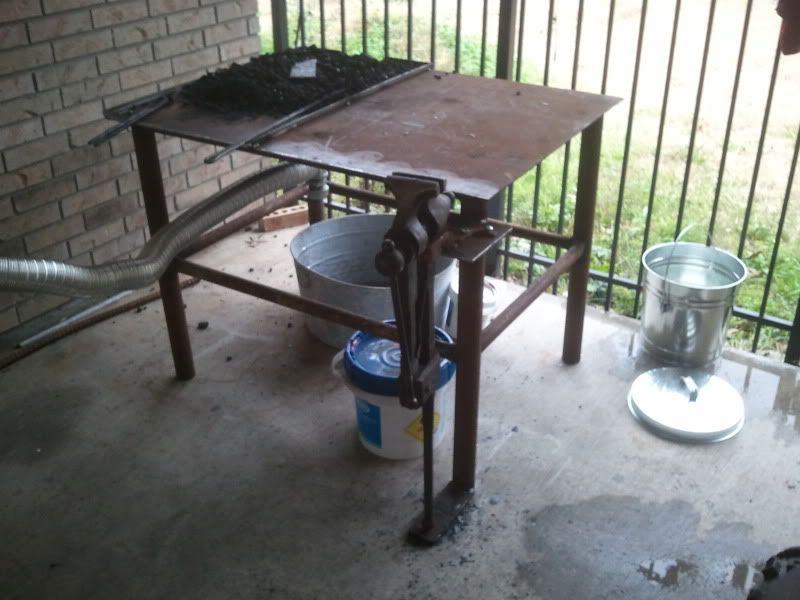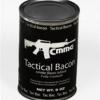-
Posts
28 -
Joined
-
Last visited
Content Type
Profiles
Forums
Articles
Gallery
Downloads
Events
Posts posted by luke978
-
-
Thats a good idea.
I had a minor disaster with the forge today. I wasn't thinking when I welded the firepot in and I flush welded it under the table. Sure enough when the firepot was full up with nice hot coke it expanded, all of the welds broke, and the firepot fell off sending coke everywhere. I just filled my slack tub when it fell, so I was able to extinguish everything.
I'm in the process of enlarging the hole so I can just drop in the brake drum.
Another lesson learned. -
I went with 2X12's. I used an oak stump first, but I couldn't cut it straight enough.

-
I thought about that. I did weld on some 1/2" angle around the firepot, though I probably should have gone higher. I didn't have anything bigger laying around. I split the table with the angle iron down the middle so I could use the other half for welding etc.
-
I've been using a Lively washtub forge since I started out a couple of months ago. Its served me well but I needed something a little more user friendly, so stopped off at my father's house built one yesterday.
I used 1/4" plate for the tabletop, and 2 1/2" drill stem for the legs and 1" for the braces. The firepot is a brake drum off of a '78 dodge pickup, with a piece of 1/4" plate with holes lining the bottom:
Fabbed up a stand for my blower too:
-
It looks good. I've been planning to try the same thing.
-
Yeah....I guess I did. :)
-
Here is mine:


204lb. Cast steel with a tool steel face. -
There is almost no info on NOHAB anvils. Hopefully more NOHAB anvil owners will post info here.
Info on the company:
Swedish NOHAB company began in 1847, as Trollhättans Mekaniska Verkstad was founded by Antenor Nydqvist, Johan Magnus Lidström and Carl Olof Holm.
Nydqvist was an engineer while Holm was rather a businessman, however, both had a technical education and worked for other companies before. Prior to founding Trollhättans Mekaniska Verkstad, Antenor Nydqvist went for a three-year journey across Europe, spending most of the time in France, England and Germany. His technical expertise was well-founded and also shown by the fact that he held numerous patents dealing with water turbines, the first main product of Trollhättans Mekaniska Verkstad.
Soon, the company was renamed to Nydqvist och Holm AB (NOHAB). Meanwhile, the product scope was widened: aside from water turbines, agricultural machines and other tools were produced, too, as well as steam engines for road and railway use (starting with 1850). The first steam locomotive of entirely own production left the factory halls in 1865.
From 1867 to 1916, Antenor Nydqvist was sole proprietor of the enterprise; at that time, NOHAB became the largest private company in Sweden. In the mean time, the original factory location was given up and a new site (i. e., NOHAB's final place) was established on the opposite side of the Trollhätte canal. In 1916, NOHAB became a public company with one of its new co-proprietors being SKF (Svenska Kullager Fabriken) of Göteborg. The descendants of Antenor Nydqvist kept working for NOHAB until 1930.
In 1920, NOHAB received the largest contract to that time: the Soviet Union placed an order for 1000 steam locomotives which was, however, reduced two years later to 500 units due to political reasons. The batch, delivered between September 1921 and December 1924, cost altogether 230 million Swedish crowns which was reciprocated by the Soviet Union with 56 tons of pure gold!
The company, employing about 2600 people at that time, found no comparable orders upon completion of the 500 locomotives and promptly faced financial difficulties which could be only partly mitigated by the construction of other products, such as bridges or bridge elements.
Urged to do so by the Swedish government, NOHAB began building aircraft motors in the 1930's. The subsidiary NOHAB Flygmotorfabrik AB purchased a license for building English Jupiter engines from Bristol Aeroplane Co. and began the production in 1933. NOHAB Flygmotorfabrik AB was later renamed to Svenska Flygmotor AB, eventually purchased by Volvo in 1970. Volvo Aero AB still continues to build jet engine parts for civil and military airplanes (among them the Gripen fighters to be used in Hungary), as well as parts for the Ariane rockets of the European Space Agency.
Between 1925 and 1935, NOHAB sought the cooperation of other companies, such as BOFORS, to hold its ground. This eventually resulted in BOFORS purchasing NOHAB in 1936 which then became BOFORS-NOHAB AB. In the 1930's, the product scope included mainly aircraft motors and turbines for power stations. -
Luke, anvils don't really come around too much. Congratulations. With a comment from the native country of manufacture (thank you Harry) perhaps we will learn more eventually about your find. My experience has shown that cast anvils don't ring much. This was one of the selling points of Vulcan (quiet forging).
I think i'll start a new thread for NOHAB anvil info. These anvils seem to be fairly rare. I've stumbled across some info about the company. Maybe we can attract more people with knowledge of these anvils. -
Got the 115lb mystery anvil. I have no clue who manufactured it. The guy's great grandad used to tac kweld things to the sides and grind them off later, so no markings:


I got it for $100 in gift cards that I won from work. -
I'm going to pick up the smaller anvil in about an hour. Ill post the details later.
-
I'm starting out too. I started messing around with it last year, but didn't really start devoting time to it until last month. I've been making some forge tools and practicing with RR spikes mostly. I live just outside of Baton Rouge, and had to do some digging to find anyone who still Smiths.
Oldnrusty hosts open forge sessions at his shop, Arnold and Anvil, every Saturday morning in baton rouge. He's the only local pro smith I know of around here doing anything like that.
Join GCBA. Meetings and classes are held monthly in Covington at Buddy's shop. Its an offical ABANA chapter.
I just joined LAMA. They have monthly meetings also. -
Picked it up this afternoon and just finished cleaning it up:


The guy I bought it from was no spring chicken, and it belonged to his dad.
I don't know what the 18 means and I've found no other markings than "NOHAB" and "Sweden". I weighed it in my shop at 204lbs. It rings loudly and has tons of rebound. I'm going to have to get used to not working with a Swayback in the face!
Thanks all, for the help! -
Thanks for the info. I'm getting it for 340.00
-
I wish I could make it tomorrow. I'll be stuck at work.
-
My Mousehole anvil deal may have fallen through. I have a lead on a sweedish anvil. Its in good shape and its marked 18. I'm guessing that its 18CWT which would put it at 338lbs, but the seller has no way the weigh it. He did say it was heavy.
Did these anvils use the CWT scale, or did they not stamp the weight on them? I haven't been able to find any info on the manufacturer:

The above are the only markings. Thanks -
About a year ago I picked up this 233lb Mousehole anvil for $25. The face is swaybacked, chipped and pitted but has good rebound. It was worse but I sanded it to even out the worst of the gouges.

I'm goint to pick up this one, possibly today. We agreed on $100. The face looks to be in much better condition, though slightly swaybacked. It has been in this guys family for at least a couple of generations. His dad used to tack weld stuff to the waist of it and grind it off later, so all of the makers marks are gone. He also painted it silver. It looks to me like its another mousehole, possibly in the 1830-1895 era based on the waist/foot shape and the pritchell hole. He weighed it at 113lbs.


Was $100 a fair price and is it a mousehole? -
Thanks again Danny, for opening up your shop to us. I had a great time and am looking forward to my next visit.
-
Looks great
-
PM sent MR. Danny.
-
I stay in lafayette... about 45 minutes away, I'd love to hook up with some other smiths
I went to USL from 96'-98'. Stayed in some appartments off of Johnston St. That was a fun town. -
Thanks guys. I just sent off my LAMA membership today.
-
Are there any bladesmiths in the Baton Rouge area on this forum?


Built a new forge yesterday
in Solid Fuel Forges
Posted
I dropped it in. I beveled the edge of the brake drum to make a smooth transition.
I'm gonna pick up some angle iron next week to finish it off.
Thanks alot for all of the input!